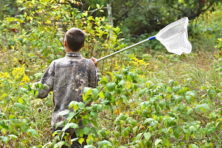Door to Nature: Monarchs and Milkweeds
- Share
- Tweet
- Pin
- Share

It is early July as I write this, and I’ve seen fewer monarch butterflies than ever at this time of year. We fear their population decline is rapidly increasing. A friend who is a nature expert said that he is seeing fewer caterpillars of many species.
Lots of people are concerned and have planted butterfly gardens. I have a raised bed of swamp milkweed and purple coneflower plants. Several years ago, there were so many monarch larvae feasting on the leaves of the milkweeds that by late summer, they were just bare stalks.
The fields of common milkweed are developing, and they often attract monarch butterflies, which deposit eggs on the plants. Once those plants grow tall and mature, the leaves become quite tough and can be inedible, especially during the unusually dry weather we have had.
Gray’s Manual of Botany lists 25 species of milkweed for North America, most of which exude a milky liquid when cut. This fluid contains cardiac glycosides, which, because they cause heart failure, are toxic to humans and most other creatures.
Strangely, the monarch larvae eat these leaves, then grow and shed their skin several times before developing the chrysalis. After about two weeks, the monarch butterfly is formed within the chrysalis shell and emerges, or ecloses.
The combination of toxic chemicals that larvae eat – and that remain in the monarchs’ body – has helped the butterfly survive because birds have learned that these flying beauties are not palatable. The smaller viceroy butterfly has adapted its colorful wing pattern to mimic the monarch, so it, too, has avoided being eaten by birds.
Common milkweed, Asclepias syriaca, is the most abundant native milkweed in Wisconsin. It has pink to cream-colored flowers and grows three to six feet tall in sunny fields and meadows throughout the state. This is the plant that forms large, warty, rounded pods in late autumn that break open to scatter silky seeds all over the landscape. That’s perhaps how this plant also got the name silkweed.
I planted swamp milkweed, Asclepias incarnata – a native species – in my raised butterfly garden. It has more tender leaves, which are very palatable for monarch larvae.
I saved seed pods from them, and a good friend who has a greenhouse got the plants started. She gave me some well-developed swamp milkweed plants in autumn a couple of years ago. I mulched them for winter protection, and most of them have now grown tall. One is about to produce flowers, but so far, no monarchs have laid any eggs on the leaves.
Swamp milkweed is sometimes called red milkweed, but the true red milkweed, Asclepias rubra, is found mainly in the far South and up the Atlantic Coast. You can tell the difference by examining the leaf veins of each species. Red milkweed has leaf veins that meet the midrib at right angles, whereas the swamp milkweed’s leaf veins are at a sharper angle. The swamp milkweed has redder flowers than the common species, so that’s why there may be some confusion.
A gardener friend also grew butterfly weed, Asclepias tuberosa, and I now have several of those in my garden. They are perennials with bright-orange flowers, and their leaves are more tender than those of the common milkweed.
The orange milkweed is the only one in this group with colorless juice, versus the cream-colored, milky liquid that all other milkweeds exude. Monarch butterflies choose both species on which to deposit their tiny, white eggs.
The population of eastern monarch butterflies has dropped by 85% during the past 25 years, mostly because the pesticides used in corn and soybean fields kill monarch caterpillars. Habitat loss, neonicotinoid insecticides, fungicides and other harmful chemicals are widely used throughout our country. West Coast monarchs in California have made a comeback during the past few years, but their population is also 85% lower than it was during the mid-1990s.
Another problem is illegal logging in the mountainous fir forests of Mexico, where these gorgeous butterflies spend the winter. The native people of this region are poor and must find ways to make an income, and unfortunately, selling these trees is one of the few choices they have.
The Center for Biological Diversity petitioned the U.S. Fish and Wildlife Service in 2014 to add the monarch butterfly to the Endangered Species Act for extra protection. The deadline for this is 2024.



